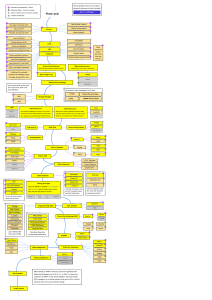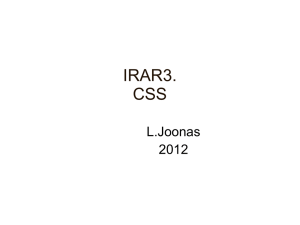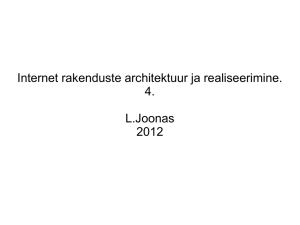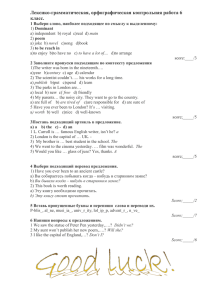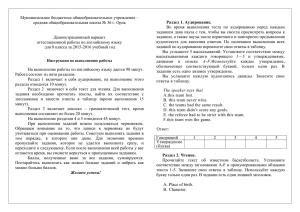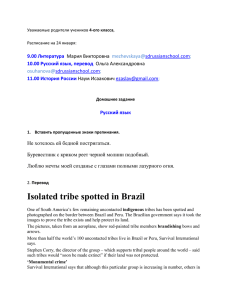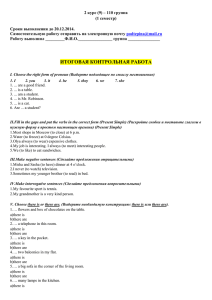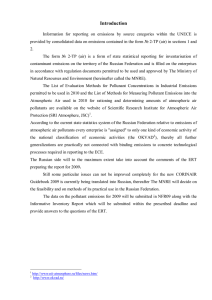Команда ввода
реклама
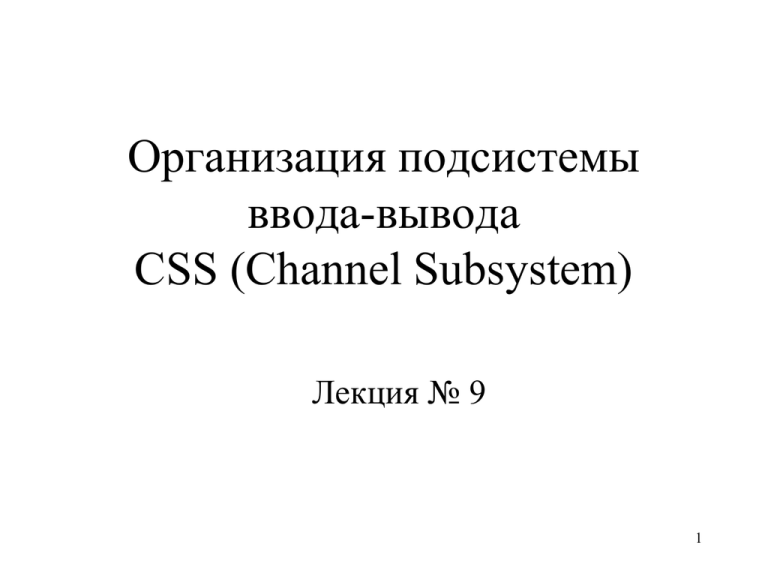
Организация подсистемы ввода-вывода CSS (Channel Subsystem) Лекция № 9 1 Channel Paths, Control Units, and Devices 2 Device Numbers • Devices (such as disks, printers, screens) are assigned device numbers from 0 to 0xFFFF by the system administrator. • These numbers are used in communication between a system operator and the operating system. • These numbers do not need to be contiguous in a configuration. 3 4 Subchannels The IOCP (I/O configuration program) reads the I/O configuration input deck. It defines the relationship between: – Channel paths – Control units and – Devices • IOCP assign a subchannel number to each device. • The numbers range from 0 to 0xFFFF and are contiguous. 5 Dynamic I/O Configuration The I/O configuration may be changed under software control by adding or deleting – Channel paths – Control units – Devices The software front-end is known as HCD (Hardware Configuration Definition) 6 7 Изменения в подканалах (Modification of Subchannels) Часть блока SCHIB может быть изменена с помощью команды MODIFY SUBCHANNEL (MSCH), а именно: – подкласс прерывания I/O (ISC); – бит применения (E). • MSCH обычно хранит блок SCHIB который использован (retrieved) перед командой START SUBCHANNEL (STSCH) 8 Starting an I/O operation 9 Starting an I/O operation 10 Operation-Request Block (ORB) • The interruption parameter is saved by the channel subsystem and returned unchanged at the time of the I/O interrupt. It is normally used by the operating system to store the address of its own device control block. • The logical path mask (LPM) can be used by the operating system to route an I/O operation to specific channel paths. Normally, the operating system sets this field to 0xFF to allow the channel subsystem to use any configured path. • The channel program address points to the first channel command word (CCW). 11 12 Типы кодов команд управляющего слова канала CCW Коды операции CCW CCW command code types: – Write (normal data output) – Read (normal data input) – Read backward (good for tapes) – Control (e.g. to position disk head) – Sense (retrieve reason for unit check) – Sense ID (retrieve device type, e.g. 3390) – Transfer in channel (branch in channel program) • The particular command code is device-specific Код операции Выполняемые действия ~~~~0000 не используется mmmmmm01 записать mmmmmm10 прочитать mmmm1100 прочитать в обратном направлении mmmmmm11 управление mmmm0100 прочитать состояние 11100100 прочитать уточненное состояние ~~~~1000 переход в канале (формат 0) 00001000 переход в канале (формат 1) mmmm1000 не используется m - биты модификации кодов в зависимости от типов устройств 13 CCW Flags • CD: chain data (use the same CCW command on the next CCW) • CC: chain command (0 = this is the last CCW) • SLI: suppress incorrect length indication • SKP: do not read data on input • PCI: program-controlled interruption (generate intermediate I/O interrupt when this CCW is fetched) • IDA: indirect data addressing • S: suspend channel program without generating I/O interrupt 14 Indirect-Data-Address Words (IDAWs) • IDAWs are used to describe I/O buffers that are contiguous in virtual storage – and thus usually scattered in absolute storage. – With z/Architecture, they provide the only means to address data buffers above 2G. • IDAWs are used when the IDA flag is set in the CCW. The address in the CCW points to the list of IDAWs. – Format-1 IDAWs are 32 bits long and cover up to 2K of storage – Format-2 IDAWs are 64 bits long and cover up to 4K of storage • When ORB word 1.14 (H) is 1, format-2 IDAWs are used. When ORB word 1.15 (T) is also 1, the IDAWs cover a 2K area, otherwise, they cover 4K. 15 Indirect-Data-Address Words (IDAWs) 16 Conclusion of I/O Operations • When the last CCW has been processed, the channel signals ending status to the channel subsystem • The subchannel is now made status-pending and an interruption condition is generated for its I/O-interruption subclass (ISC) • An I/O interrupt is said to be floating, i.e. it is “offered” to all CPUs that are enabled for this ISC • If more than one CPU is enabled for this I/O interrupt, only one will actually take it • As an alternative, the CPU may poll for an interrupt using the TEST PENDING INTERRUPTION (TPI) instruction 17 Conclusion of I/O Operations 18 Conclusion of I/O Operations 19 Conclusion of I/O Operations 20 Conclusion of I/O Operations 21 Способы выполнения канальных программ В зависимости от типа каналов в z/Architecture возможны три способа выполнения канальных программ: – байт-мультиплексный (byte-multiplex mode); – блок-мультиплексный (burst mode); – фрейм-мультиплексный (frame-multiplex mode). 22 Структура фрейма 23 z990 Extensions to I/O Architecture • Multiple channel subsystems (MCSS) • 1 to 4 logical channel subsystems (LCSS) – Up to 256 channel paths per logical partition (LPAR) – Up to 63K devices (subchannels) per LPAR – An LCSS may be shared by multiple LPARs • Allows much larger configurations (e.g. To consolidate two z900 systems on a single z990) 24 z990 – I/O Configuration Support 25 z990 – I/O Configuration Support 26 z9 Extensions to I/O Architecture • Multiple subchannel sets (MSS) • The problem: z990 had only one subchannel set – 64,512 subchannels (1,024 reserved for internal use) • This became a problem for large installations because of PAV (parallel access volumes): – With PAV, a single disk drive often consumes four subchannels (base address plus three aliases) • The solution z9 supports two subchannel sets – 65,280 subchannels in set 0 (256 reserved for internal use) – 65,535 subchannels in set 1 • z/OS 1.7 exploits second subchannel set to access alias addresses of parallel access volumes (PAV) 27 z9 – I/O Configuration Growth - Multiple Subchannel Sets (MSS) 28 z9 – Multiple Subchannel Sets per LCSS 29 Modified Indirect-Data-Address Words (MIDAWs) • MIDAWs were invented to increase I/O throughput by reducing the number of CCWs required. • Like IDAWs, MIDAWs specify a list of data areas in absolute storage. • Unlike IDAWs, MIDAWs are used to describe I/O buffers that are scattered in virtual storage: – MIDAWs never have to specify aligned addresses (the areas must not cross 4K-boundaries, though). – Each MIDAW has its own count field. • MIDAWs were introduced with the IBM System z9. • Use of MIDAWs must be enabled in the ORB (D-bit, word 1, bit 25). • The MIDA flag must be set in the flags of the CCW (bit 15 in format1 CCW). When it is used, neither IDA nor SKIP flags must be set. • The CCW points to a list of MIDAWs (MIDAL). • The MIDAL begins on a quadword boundary. It must not cross a 4K boundary. 30 MIDAW layout 31 Initial Program Loading (IPL) • Boots the operating system from an I/O device • Initiated manually at the support element (SE) or hardware management console (HMC) • System operator specifies device number • Operator may specify an IPL parameter that is retrieved later by the operating system with a SERVICE CALL instruction (SERVC, also known as SCLP) 32 Initial Program Loading (IPL) 33 IPL Process 34 Функциональный состав CSS • Настройка и управление ПУ • Операции вводавывода • виртуальные соединения между логическими разделами сервера • Channel Subsystem – CSS • канальные программы Channel Programs • Внутренние каналы = подканалы Subchannels 35 Варианты исполнения CSS 36 Варианты исполнения CSS 37 Общая организация канальной подсистемы CSS 38 Параметры канальных подсистем Параметры канальных подсистем S390 (G5/G6) z800, z900 1 на сервер z990 CSS 1 на сервер 2 на сервер Логические разделы 15 на сервер 15 на сервер 15 на LCSS 30 на сервер Подканалы 288 К на сервер 512 К на сервер 945 К на LCSS 1890 К на сервер Канальные пути 256 на CSS 256 на сервер 256 на сервер 256 на LCSS 256 на CSS 512 на сервер Периферий ные устройства 36 К на сервер 63 К на сервер 63 К на LCSS 126 К на сервер 39 Адресация в подсистеме ввода-вывода 40 Идентификация объектов канальной системы 41 Формат команды ввода-вывода Адресация устройств в командах вводавывода 0 Команда вводавывода COP 0 GR 1 15 19 B2 31 31 D2 47 0000000000000001 63 SCBNUM 42 Идентификация объектов канальной системы Идентификатор подсистемы 0 ˜ 31 39 43 47 63 CSSID IID 0001 SCBNUM 43 Принципы выполнения операций ввода- вывода в канальных подсистемах • Распараллеливание работы большого числа периферийных устройств • Каждой операции ввода-вывода • Параллельно функционирующие каналы в CSS • своя канальная программа, определяющая параметры обмена • каналы реализуются как процессоры со специализированной системой команд 44 Принципы выполнения операций ввода-вывода в базовой архитектуре 45 Принципы выполнения операций ввода-вывода в базовой архитектуре 46 Выполнение операций ввода-вывода в архитектуре zSeries 47 Основные отличия канальной подсистемы z/Architecture от базовой архитектуры 48
